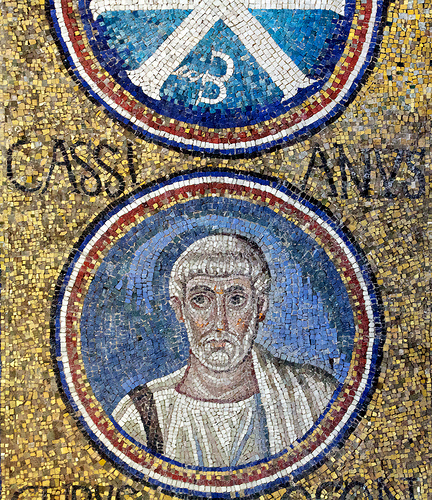Abba Cassian, the Great Ascetic of the West
29 February 2016Saint John Cassian the Roman
By and large, Saint Cassian has been relatively unknown to most of the members of the Orthodox Church, even though he is an important Patristic figure. This is because he wrote in Latin, to which they did not have access. Only a few parts of his writings were translated into Greek at an early date.
He lived towards the end of the 4th century, about 360-5. So far, researchers have been unable to locate where exactly he was born. There are two contenders for the country of his birth: Lesser Scythia and Southern Gaul. The most likely is Lesser Scythia, where the River Danube debouches, in what is today’s Dobrudzha, in Romania.
There is some uncertainty regarding his name. Some authors refer to him as Cassian, though in his own writings he called himself John. A contemporary of his mentions that he was called ‘John, also known as Cassian’. The most likely answer is that his name, either baptismal or after his tonsure, was John and that Cassian was a sobriquet.
His family was prosperous and God-fearing and provided him with the opportunity to acquire a sound and broad education. He himself, in his writings, confesses that continuous study absorbed much of his spiritual effort and was an obstacle to his prayer life. He was familiar with the works of the Fathers of the Early Church and of other authors.
As a young man, and in the company of his close friend Germanos, he followed the monastic life in a monastery in Bethlehem which was near the Cave of the Nativity of the Lord. Here he became familiar with the monasticism of Palestine, Syria and Mesopotamia. He longed for the life of a hermit and an ascent into the higher realms of spirituality, however, so, again with his friend Germanos, he decided to visit the anchorites in Egypt. Having obtained the blessing of the Abbot, they visited three famous abbas, Hairimon, Nisthro and Iosif, as well as the famous coenobium monastery of Abba Pinoufrios. They continued into the desert at the mouth of the Nile and met fathers with whom they discussed the details of the monastic life.
Seven years later, they returned to the Monastery in Bethlehem, but shortly afterwards returned to Egypt to visit the desert of Skete, in the valley of Nitria, where they met Abba Moïsis, Abba Pafnoutios, Abba Serapion and other great fathers. Cassian conversed with them and recorded their lives in the monasteries and their spiritual and ascetic experiences. Both visits to Egypt must have take place between the years 380 and 400.
After the deposition and exile of Chrysostom, Cassian went to Rome and delivered to Pope Innocent a letter from the clergy and people of Constantinople. He remained in Rome for some ten years, in the service of the Church, and it was probably here that he was ordained to the priesthood.
In about 415, we find Abba Cassian in France, in the Marseilles region, where he founded two monasteries: one for men, dedicated to Saint Victor, a third century martyr; and the other for women dedicated to Christ the Saviour. Both of these were organized on the model of the coenobitic monasticism of the Orthodox East.
In Marseilles, an environment that was suspicious of the monastic life, he provided a theoretical defence of monasticism with his three great works: De Institutis Coenobiorum (On the Institutions of the Coenobitic Monasteries; Collationes Patrum (Discussions with the Fathers); and De Incarnationem Domini Contra Nestorium (On the Incarnation of the Lord, against Nestorius).
He fell asleep in the Lord in 435 and his holy relics are kept in the Monastery of Saint Victor. The Orthodox Church has declared him a saint and his memory is honoured on 29 February. In his book, Pages about Saint Cassian the |Roman in the Old Town of Nikosia (in Greek, Akti, 1997), F. Dimitrakoupoulos, Professor of Byzantine Literature at the University of Athens, mentions that in suffering Cyprus 25 churches are dedicated to him and his feast day is celebrated. Another reason for his marginalization by the Western Church was that he was the leading opponent of Augustine’s theory of predestination, which was adopted by Western theology.







